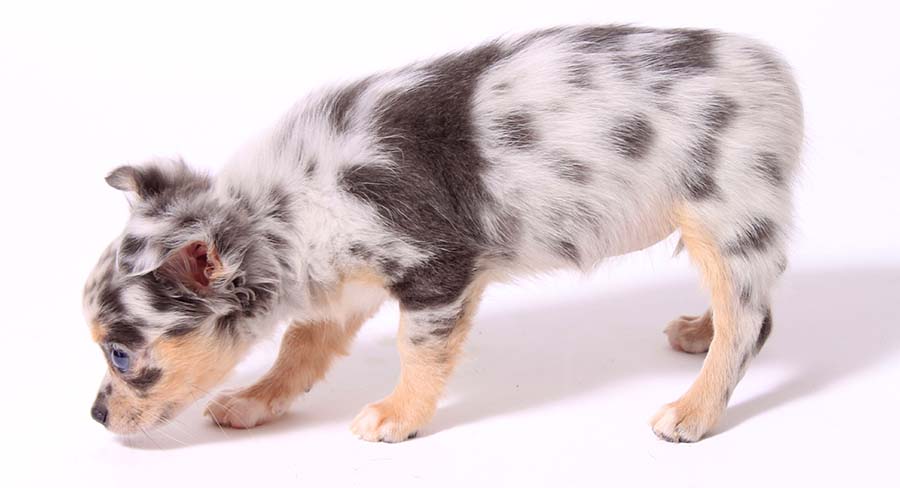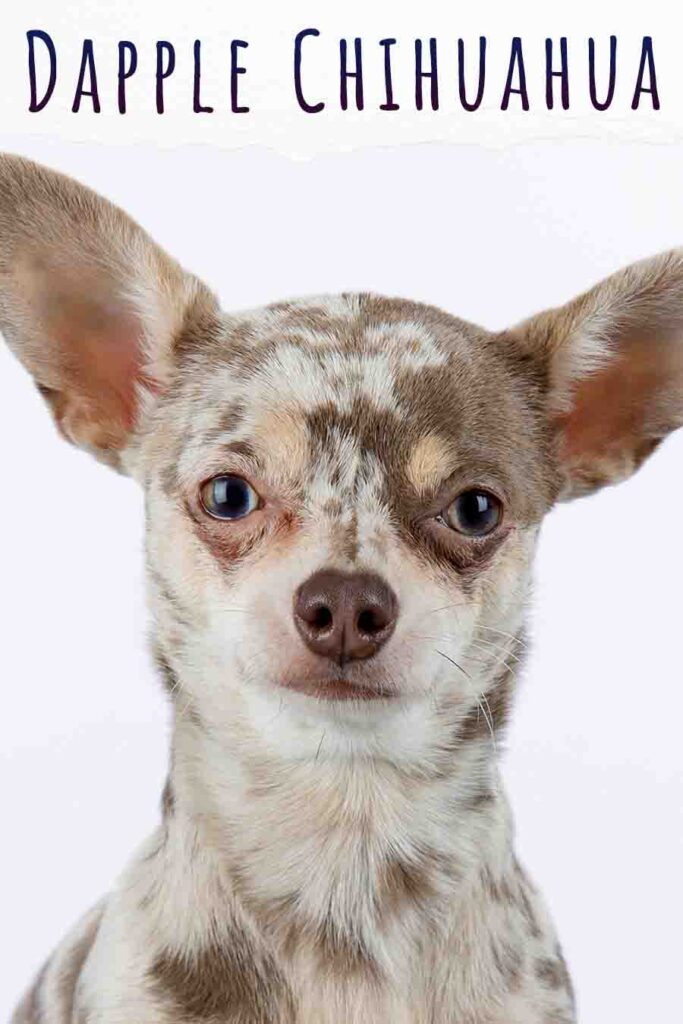
What is a dapple Chihuahua like as a pet? Are they distinctly different from the other Chihuahua colors? This detailed doggy digest will answer all your questions!
- What is a dapple Chihuahua?
- What does a dapple Chihuahua look like?
- Dapple Chihuahua genetics
- Are dapple Chihuahuas healthy?
- Dapple Chihuahua Temperament
Dapple Chihuahua is another name for a Chihuahua with merle coloring. Merle puppies have irregular spots, splodges, splashes and speckles of light and dark pigment in their coat. Spotted Chihuahua coats are very attractive and sought after. But they are also directly linked to some notable health problems.
This gorgeous long haired merle Chihuahua Ziggy has eye catching black dappling on a grey background. Let’s find out more about what makes him and other dappled Chihuahuas so special!
What is a Dapple Chihuahua?
Puppies born into the iconic Chihuahua dog breed can be registered in ‘any color – solid, marked, or splashed’. In fact the American Kennel Club provides registration codes for no less than 31 different color possibilities and 11 different patterns. One of these patterns is ‘merle’, and you won’t have to search hard to find pictures of a blue merle Chihuahua or a chocolate merle Chihuahua. It’s these merle colored Chihuahua dogs that are sometimes described as dapple Chihuahuas instead.
‘Dapple’ is the correct word used to describe merle coats on Dachshunds. But technically merle is the correct term to use for Chihuahuas. They are the same pattern, but the breeds just have different naming conventions. (In fact, Dachshunds are the only breed that use dapple – they are different from everyone!)
What do dapple Chihuahua puppies look like?
Let’s set aside quibbles about terminology for a moment, and focus on what this coat actually looks like. Dogs with a dapple or merle coat have an irregular pattern of dark and light pigmentation in their fur. The dark patches can be big bold blotches, or delicate small speckles. No two merle dogs look exactly the same. You can even get a dapple long haired Chihuahua, and there are lots of color possibilities too:
- Black dapple Chihuahuas like Ziggy above have black markings on a dark grey background.
- A chocolate merle Chihuahua has brown markings on a light brown background.
- A blue dapple Chihuahua is especially popular. These are black dapple dogs with color dilution, so the dark pattern on their coat is a soft dove grey, and the background is a super light platinum color.
- You can even get a lilac Chihuahua with a dapple pattern. Lilac dogs are chocolate dogs with color dilution, so lilac dapple dogs have a pattern of cafe-au-lait markings on a very pale fawn background.
- And finally, merle Chihuahuas can also have tan points (like the pup in our pictures), or white markings (like Ziggy). But for health reason we’ll come to in a moment, white markings should never cover more than one third of their body.

There are also some traditional Chihuahua colors and patterns which can’t be combined with merle. These coats mask the merle pattern:
Dapple Chihuahua Genetics
Unlike most coat colors, where the genes that cause them are just an interesting insight into a dog’s DNA, the genetic basis of the dapple pattern is actually a very serious and important matter. Dapple patterns are caused by a gene called the merle gene. The merle gene is a dominant gene, which means that a puppy need only inherit one copy from one parent, in order to express the dapple pattern. Variation in the degree of dapple patterning is determined by how many repetitions of a particular molecular sequence occur within their merle gene. The different levels of dappling (or merling) are categorized by biologists as:
- Cryptic. Only tiny patches of merle appear in the coat, or even none at all.
- Atypical. Unusually small amounts of merle pattern in the coat.
- Classic. See the pictures accompanying this article.
- Harlequin. Very distinct dappling indeed, usually with the addition of white patches.
If a puppy inherits two copies of the merle gene (one from each parent), they are known as a ‘homozygous merle’, or a double merle merle Chihuahua. Being double merle is associated with a significantly increased risk of health problems.
Dapple Chihuahua Health
In one study of merle dogs, 1 in 28 dogs with one copy of the merle gene were found to be deaf in at least one ear. Among dogs with two copies of the merle gene, 1 in 10 dogs were deaf in one ear, and 1 in 7 dogs were deaf in both ears. Other studies have put the risk of hearing loss in homozygous merle dogs closer to 50%. Homozygous merle dogs are also more likely to have abnormalities in their eyes, including:
- Abnormally small eyes.
- Increased pressure inside the eye.
- Inability to focus properly.
- Missing tissue in the eye structure.
So like most breed clubs, the Chihuahua Club of America specifically counsels breeders not to risk producing them. This includes not mating one dapple dog to another, and also not mating a dapple dog to one of the four colors that conceal the presence of the merle gene without prior DNA screening.
More generally, Chihuahuas are also vulnerable to:
- Cardiovascular disease.
- Traumatic injuries eg. due to falling from furniture – these are made worse because their tiny size makes them extra fragile.
- Patella luxation.
- Dental diseases.
- Obesity.
- Anal sac impaction.
On average, Chihuahuas live for 12 to 13 years.
Dapple Chihuahua Temperament
The tiny Chihuahua’s temperament is legendary, and completely out of proportion to their physical size. They are charismatic, regal, and larger than life. Just because they’re small doesn’t make them less of a commitment than larger dog breeds either. Chihuahuas are one of the breeds most prone to: fear and anxiety triggered by unfamiliar people, unfamiliar dogs, loud noises, touch, and separation. They also display higher rates of stranger-directed aggression, owner-directed aggression, and dog rivalry than almost any other dog breed. On top of all this, small size is linked to an increased probability of a dog owner reporting unwanted mounting behavior, toileting indoors, begging behaviors, attention seeking behaviors and hyperactivity. In fact just about the only unwanted behavior that Chihuahuas don’t display more than average is predatory chasing.
All this is true of dapple Chihuahuas too. But, researchers have speculated that because Chihuahuas’ size makes their unwanted behavior relatively ‘low impact’, owners are more likely to tolerate it that do anything about it. So there’s a reasonable chance that lots of these issues can actually be managed or overcome through proper socialisation and training.
Merle Chihuahua Puppies
If you’ve already seen a litter of blue merle Chihuahua puppies for sale and started to fall in love, here’s are some of the things you need to ask their breeder:
- Were their parents health tested for heart disease, eye disease, and luxating patellas (at a minimum)?
- What colors were the parents? If either belonged to a color which conceals the merle gene, what steps did they take to make sure their puppies aren’t double merle?
- Where will the puppies be raised, and what socialisation will the breeder do with them before they are ready to come home?
You can find out more about choosing a good breeder and finding a healthy puppy in these Puppy Search resources.
Your Dapple Spotted Chihuahua
A blue merle Chihuahua is bound to get compliments when you step out together! To make sure they are healthy and happy as well as beautiful, it’s important to choose a puppy carefully from a reputable, knowledgeable breeder.
If you already own a dapple Chihuahua, tell us about them now in the comments box down below!
More Articles
- Meet the oh-so chic blue Chihuahua here.
- Find out which other dog breeds can have merle puppies right here.
- Discover some more rare Chihuahua colorsin this list.
- Find out how hard a Chi can nip here.
- And find out more about why they can be so cranky in this article!
References and Resources
Brancalion et al. Canine coat pigmentation genetics: a review. Animal Genetics. 2021.
Fleming et al. Mortality in North American Dogs from 1984 to 2004: An Investigation into Age-, Size-, and Breed-Related Causes of Death. Journal of Veterinary Internal Medicine. 2011.
McGreevy et al. Dog Behavior Co-Varies with Height, Bodyweight and Skull Shape. PLOS One. 2013.
Merle Statement. Chihuahua Club of America. Accessed January 2022.
Official Standard of the Chihuahua. American Kennel Club. 2008.
O’Neill et al. Demography and commonly recorded clinical conditions of Chihuahuas under primary veterinary care in the UK in 2016. BMC Veterinary Research. 2020.
Orthopedic Foundation for Animals.
Serpell & Duffy. Dog Breeds and Their Behavior. Domestic Dog Cognition and Behavior. 2014.
Strain et al. Prevalence of Deafness in Dogs Heterozygous or Homozygous for the Merle Allele. Journal of Veterinary Internal Medicine. 2009.

Leave a Reply